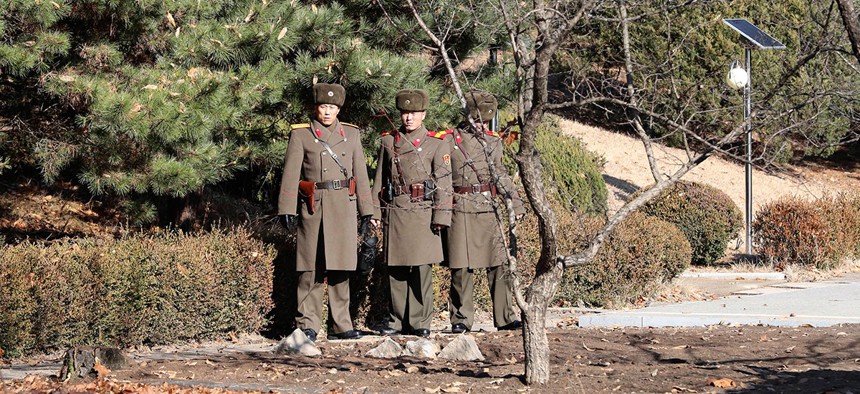
North Korean soldiers keep watch where a North Korean defector crossed the border on November 13, at the truce village of Panmunjom inside the demilitarized zone, in South Korea, on November 27. Lee Jin-man/AP
North Korea Ends Its Pause in Missile Tests
Along with speculation it was signaling a desire for talks
On Tuesday in the U.S.—Wednesday in Asia—the world’s two-and-a-half month respite from North Korean provocations came to an end. Yonhap, the South Korean news agency, reported that the North had fired a ballistic missile heading east; NHK, the Japanese broadcaster, said this one, like several before it, may have landed in the waters off Japan. The Pentagon’s initial assessment was that the missile was an ICBM, the type of long-range missile that could reach the United States, which the North has tested twice before.
The launch also ended speculation that the North was observing a lull in testing as a show of good faith to the United States, in order to pursue talks on the communist state’s missile and nuclear programs. On October 30, America’s special envoy for North Korea policy declared that if the North ceased testing for 60 days, it might be a sign the country was open to diplomacy. Sixty days came and went, but as Van Jackson wrote at The Atlantic, there were explanations besides a desire to make peace, including the harvest season, and the military’s training schedule. Regardless, the resumption of testing means that this year alone North Korea has tested at least 20 missiles, according to the database maintained by the Nuclear Threat Initiative. The figure for 2016 was 24; it was 15 in 2015.
The launch also comes a week after President Trump re-added North Korea to the list of state sponsors of terrorism; the country had been removed from it over a decade ago. That designation, and its accompanying sanctions, was in line with the “maximum pressure, maximum engagement” strategy the Trump administration has articulated for dealing with North Korea—though at times it appears, publicly at least, that only the first part of the policy is in effect. U.S. Secretary of State Rex Tillerson and other national-security officials have said, nevertheless, that they are optimistic about the possibility of dialogue with the North on its missile and nuclear programs. Despite this, though, there is currently little communication between the two countries. Tillerson said in September the U.S. had “three channels open to Pyongyang”—for communication if not negotiation—but Trump himself has publicly undercut them, saying Tillerson was “wasting his time” trying to conduct diplomacy.
In any case, those who favor tough action against North Korea will probably see the latest missile test as a vindication of Trump’s position. It’s not clear though whether tough action can actually bring about a change in North Korea’s behavior. This is, after all, one of the world’s most heavily sanctioned countries; several countries have recently expelled the North Korean envoys from their capitals, as part of a coordinated international diplomatic effort; and the North’s chief ally, China, is getting impatient with its actions. North Korea is, in Russian President Vladimir Putin’s words, willing to eat grass in order to possess nuclear weapons.
Experts say it already possesses enough fissile material for at least 20 such weapons. Its intercontinental ballistic missiles are already theoretically capable of reaching the contiguous United States, and the country is believed to be mere months away from fitting a miniaturized nuclear warhead onto such a missile.
So where does this end? Many U.S. experts who favor a tough response to the North say that North Korea’s intent is to compel the United States to abandon its alliance with South Korea, and to force reunification of the peninsula on its own terms. But China, North Korea’s largest trading partner, sees it differently. As I reported today, Chinese experts say North Korea already possesses the nuclear material required to achieve those goals, and its continued provocations are a way to seek security guarantees. This fundamental difference of opinion between the United States and China, which says it understands North Korea’s worldview, is a major obstacle in any resolution of the current crisis. (The U.S. has also pressed China to do more to cut off North Korea’s economic lifeline, and Beijing says it will comply up to a point: It doesn’t want to destabilize North Korea to the point the regime collapses; doesn’t want chaos in its backyard; and doesn’t want a pro-U.S. country with U.S. troops at its border.)
The test will almost certainly end the optimistic statements coming from U.S. officials in recent days in response to the lull in testing. There were Tillerson’s remarks in September about channels. This month James Mattis, the U.S. secretary of defense, said the pause could lead to direct talks. But Trump, responding the test on Tuesday, had another message. “We’ll take care of it,” he said.






